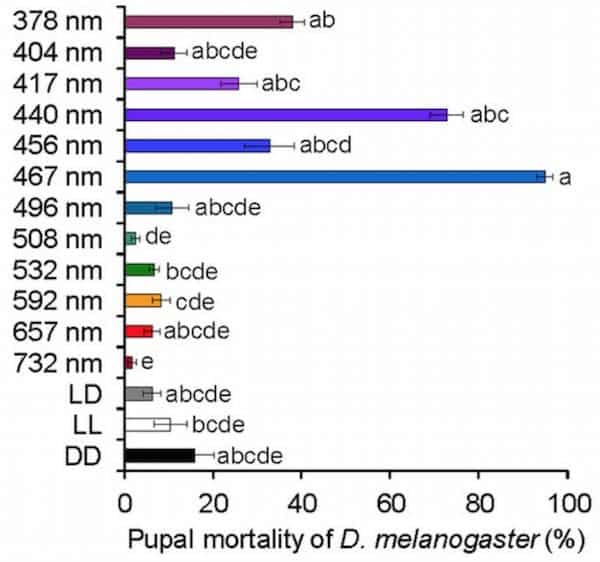Keeping insects at bay is more than eliminating a simple nuisance – in many some parts of the world, it’s vital. Malaria, an infectious mosquito-borne disease kilss over 500,000 people every year, and the disease could be kept under control if the mosquito population was kept under control; this is where this study steps in.
Some insects provide many environmental services, but many others are simply regarded as pests. For farmers working the land or for people in the poorer areas, insects can be a huge problem, causing major economic damage, and sometimes causing life-threatening diseases. Many solutions have been proposed for such situations, but for the most part, farmers still use insecticide to kill pests and people in Africa use bed sheets and other physical protection against mosquitoes. But insecticides are toxic to humans and bed sheets only get you so much, so a better solution would be more than welcome. This is where blue light comes in.
Japanese researchers from Tohoku University describe in the journal Scientific Reports that certain wavelengths of visible light are lethal to certain species of insects. For instance, blue light (wavelength = 467 nm; lights of different wavelenghts have different colors in the spectrum) was nearly 100% lethal to fruit fly pupae, while ultraviolet A light (wavelength = 378 nm) was only about 40% lethal.
They went on and found that pupae of the London Underground mosquito (Culex pipiens molestus) were killed by violet/indigo light (417 nm), while pupae of the confused flour beetle (Tribolium confusum) were killed by several different wavelengths of light, ranging from violet to blue. Of course, in nature, insects are also subjected to these wavelengths, but in the study, they were subjected to much more light than they would have naturally.
“We also investigated the lethal effects of various bluelight wavelengths (404–508 nm) on pupae of the mosquito Culex pipiens molestus. Blue light irradiation was lethal to mosquito pupae, although their tolerance was higher than that of D. melanogaster pupae”, researchers write.
Researchers also suggest that different wavelengths could kill different bugs, and that this technology could actually be used practically in many environments. The key thing here is that people would be able to selectivelly kill pests, while leaving friendly ones unharmed. It would also reduce pesticide use, making foods less dangerous for humans, but the downside is that it would take a lot of energy. Illuminating whole fields with blue LEDs is no easy feat, and I’m not sure how the economic side factors into this one (this wasn’t tackled in the study). If the price is lower, comparable, or even just a bit higher, then it would be avantageous to use. If it’s much higher, I’m not sure farmers would adopt the method.
Also, if you want to keep multiple insects at bay, you have to use multiple types of LEDs. UV light is by far the most efficient type of light, but it can also be harmful to mammals. All in all, a very interesting find, but there’s still a way to go before this can be used practically.
Journal Reference: Masatoshi Hori, Kazuki Shibuya, Mitsunari Sato & Yoshino Saito. Lethal effects of short-wavelength visible light on insects. Via Nature.










